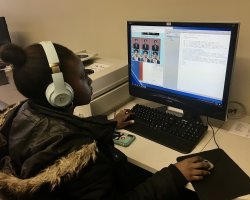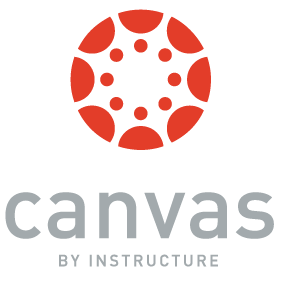Student-oriented Training Modules Prepare Students for Future Careers
Students at CDH Create a Canvas Training Course for New Trainees.
Posted in: Announcements, News, Projects

Prior to the Spring 2018 semester, the Center for Digital Humanities’s (CDH) new Federal Work-Study students worked on their software skills by training themselves within the lab. Given a list of different software, ranging from Openstreetmap to Adobe Premiere Pro, the new hires were initially self-taught while working at CDH. Working on these softwares with no rubric or hard structure, the trainees were at different skill levels in these programs. With a skills gap among the student team, the new trainees needed a common learning ground.
AJ Kelton, Director of the Center for the Digital Humanities, noticed this disparity and knew that creating a training course could potentially solve this issue. So for the Fall 2018, he asked the senior members, those who have completed their training the semesters prior, to help create a training module. His vision for the training course included having the students create, run, and monitored by the students. The students, who took the lead in creating the training course, used inspiration from their prior experience working at CDH and from other classes to create a hybrid of the two.

Using Canvas as the home for the training module, it allowed the students to use something that was comfortable and reliable. There were still many issues that came up along the way, like making sure that the training course was going to work. Since this was the first time the Center for Digital Humanities at Montclair State has ever done something like this, it was a risky move. To properly train the new hires, the training course had to be intricate and suited to students’ needs and technological advances in education. It all revolves around benefitting the students and their ability to expand their portfolio for future careers.
Each module consists of a ‘genre’ or technology type, including video editing, audio manipulation, programming languages (HTML), etc. Within these modules consist of assignments that are more specific that each student must complete before moving on to the next module. There is a module dedicated to video manipulation that has assignments specifically tailored to video manipulation with programs like Imovie, Adobe After Effects, and Adobe Premiere Pro. Each module is set to train a specific field of skills but within the module are different programs used within that field. At the end of each module, there is a test that quizzes the trainees on everything contained in the respective module. Student trainees must pass in order to move to the next module.
Looking back at a year’s worth of work, the training modules are still being updated with corrections. The student team is constantly going back and making sure that the modules are error-free, which is something they consistently have to do because the work environment is always changing. The team in charge of the training course also receives input from the trainees after they finish the training modules. Within the last year, these modules have been completely rearranged. This allows for a better flow of the training course and so the modules don’t face issues.
The team has created a space at the CDH where everyone has a consistent level of training. The impact of teaching Montclair State University students these skills move beyond their years at this school. These are transferable skills that can be utilized anywhere and for almost all fields of work.
